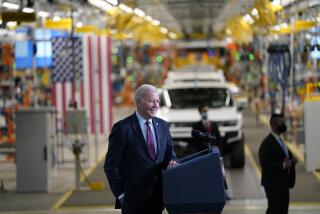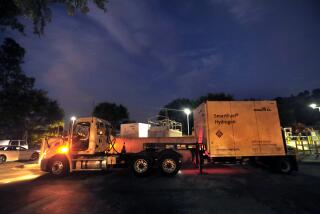Obama to target power plants’ carbon dioxide emissions
CHICAGO — On Monday, President Obama plans to unveil what is likely to be the most significant initiative of his presidency to combat climate change: a new rule to cut carbon dioxide emissions from existing power plants, the country’s single greatest source of the heat-trapping gas.
In Washington, the announcement, which would bypass Congress and use Obama’s authority under the Clean Air Act to achieve greenhouse gas reductions, will stir threats of lawsuits, claims of job losses and charges that the president has revived his “war on coal.”
By contrast, in some coal-reliant states, power companies and regulators are talking of a more pragmatic approach, planning for a future they assume will include carbon dioxide limits.
“Carbon policy is going to impact our business, and we have to be prepared for that,” said Robert C. Flexon, chief executive of Houston-based Dynegy. “It can be a threat or an opportunity. I’d rather make it an opportunity. You can sit and whine about it or find innovative ways to deal with it.”
Which approach prevails — an all-out political and legal fight or a compromise — will help determine how quickly the U.S. will begin to reduce its greenhouse gas emissions.
Cutting carbon dioxide from power plants involves enormous stakes. Power generation accounts for roughly 40% of U.S. greenhouse-gas emissions. But while seeking to reduce pollution, the administration must ensure that electricity supply remains reliable and consumer rates reasonable.
The problems involved in achieving both those goals — as well as some potential approaches — are on display in Illinois, which gets just over 40% of its power from coal, including nine plants operated by Dynegy. Of the rest, most comes from nuclear plants and about 8% of the state’s overall power is from renewable sources, much of it wind.
Although some older coal-fired power plants in the state already have closed, power executives, regulators and some environmentalists here acknowledge that many will need to keep running for some time, although at less capacity. The reduced output could be made up through energy efficiency and renewable power, they say.
“We’re pretty consistent with what you’re hearing from other states, that you can’t have a one-size-fits-all approach but a suite of tools instead to use to cut emissions,” said Lisa Bonnett, director of the Illinois Environmental Protection Agency. “We’re really hearing that the EPA will provide that flexibility.”
Much of the wrangling over the rule probably will center on its stringency: What baseline will be used to determine how much states have to reduce their emissions? Will states have different standards to meet depending on how much coal generation they have? Will states get credit for cuts they already have made to emissions?
The Obama administration wants the rule in place by the end of 2016, just before the president’s term is up, but given the likelihood of legal challenges, it is unclear when the pollution cuts might take effect.
In the past, the federal Environmental Protection Agency has ordered individual power plants to cut specific pollutants by set amounts. But that approach doesn’t work for carbon dioxide because technology that would allow coal plants to cut those emissions is not currently cost effective.
Instead, the EPA is expected to propose a rule that sets overall pollution-reduction targets for states and gives them considerable flexibility on how to meet those goals.
In effect, the new rule would enact some features of the so-called “cap and trade” plan that passed the House early in Obama’s tenure but died in the Senate. States would have an overall ceiling on the amount of greenhouse gases their power plants could emit — the cap. They could allow utility companies to trade in the hope of finding efficient, low-cost ways to achieve those goals.
Many energy companies have a mix of plants that use different fuels, and some could run cleaner units powered by natural gas or wind and reduce the use of coal-fired generators.
For the gigantic Prairie State plant in the southern Illinois village of Marissa, however, coal is all there is.
The largest coal plant built in the United States in the last three decades, Prairie State was erected in 2012 at the mouth of a coal mine by a consortium of municipal utilities from several states. Its 14-story generation complex can produce 1,600 megawatts of power to serve about 2.5 million customers.
Thanks to $1 billion in the latest pollution-control technology, it emits less pollution, including mercury and sulfur dioxide, than other coal plants. Still, Prairie State’s carbon dioxide output is greater than 90% of the country’s power plants, according to EPA data, and it cannot cut emissions enough to rival cleaner electricity generation. Already, the power it generates is more expensive than electricity from some natural gas plants, a gap that has generated complaints from communities that buy its output.
The plant’s executives have met with EPA officials on several occasions to make the case for more time, said Ashlie Kuehn, Prairie State’s general counsel. The company has considered several options to offset the plant’s emissions.
“Do we install solar panels in our parking lot? Plant trees? Do we partner with a renewables company?” Kuehn said. “I’m confident EPA heard our concerns. But we’re on pins and needles.”
Chicago-based Exelon owns the state’s six nuclear plants, which do not emit greenhouse gases. Utility officials have said they have considered closing as many as five of them because current electricity prices make recouping the cost of the reactors impossible. A rule that would limit coal-generated electricity would help Exelon’s bottom line.
“There’s a lot of talk about how greenhouse gas rules would negatively affect coal plants, and that’s true,” said Joseph Dominguez, senior vice president of regulatory affairs at Exelon. “At the same time, not having greenhouse gas rules negatively affects the expansion of clean energy. The rule could help us. Right now, nuclear isn’t compensated for its zero-emission profile.”
Environmentalists, such as Howard Learner, executive director of the Environmental Law & Policy Center, a Chicago-based advocacy group, hope the rule will foster greater energy efficiency and renewable energy use. In 2007, Illinois passed a law that requires power companies to reduce electricity consumption by 2% every year through energy efficiency programs and incentives.
“I think the focus of a new rule can’t just be about coal as the bad guy,” said Anne Evens, chief executive of Elevate Energy, a Chicago-based nonprofit that improves energy efficiency in affordable housing and other large buildings. “In many cities, energy consumption from housing accounts for two-thirds of greenhouse gas emissions, and there is so much potential to reduce energy consumption, especially in the Midwest with its older housing.”
Other potential offsets to coal emissions are already taking root because of a state law, similar to those in several other states, that calls for 25% of Illinois’ power to come from renewable energy by 2025.
Along a 17-mile stretch in central Illinois, 240 wind-turbine towers rise from the newly planted corn and soybean fields by the villages of Ellsworth, Arrowsmith and Saybrook. The strong winds that blow through McLean County all winter drew Houston-based EDP Renewables to the area eight years ago.
The new greenhouse gas rule could prompt the company and others to build more wind turbines.
Sitting in an office at the back of his Doyle Oil shop in Ellsworth, Jack Doyle, 85, said he isn’t up to speed on the power plant rule, but if he could lease more of his land for wind turbines, he would.
He researched the issue while on vacation in California, sneaking through a fence into a wind farm and talking to an employee. Now, Doyle has seven turbines on this land and half of one that straddles a neighbor’s land.
“I don’t know about all that stuff in Washington,” Doyle said, “but the wind is up there doing nothing, so why not use it to make electricity?”







